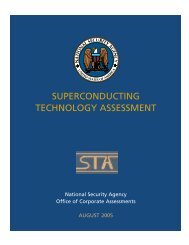Untitled - nitrd
Untitled - nitrd
Untitled - nitrd
- No tags were found...
Create successful ePaper yourself
Turn your PDF publications into a flip-book with our unique Google optimized e-Paper software.
High Confidence Software and Systems (HCSS)PREPRINT COPYNITRD Agencies: NSF, NIH, OSD and DoD Service research organizations, NSA, NIST, NASAOther Participants: DOE (OE), FAA, FDA, NTSBHCSS R&D supports development of scientific foundations and innovative and enabling software and hardwaretechnologies for the engineering, V&V, assurance, and certification of complex, networked, distributed computingsystems and cyber-physical (IT-enabled) systems. The goal is to enable seamless, fully synergistic integration ofcomputational intelligence, communication, control, sensing, actuation, and adaptation with physical devices andinformation processes to routinely realize high-confidence, optimally performing systems that are essential foreffectively operating life-, safety-, security-, and mission-critical applications. These systems must be capable ofinteracting correctly, safely, and securely with humans and the physical world in changing environments andunforeseen conditions. In many cases, they must be certifiably dependable. The vision is to realize dependablesystems that are more precise and highly efficient; respond more quickly; work in dangerous or inaccessibleenvironments; provide large-scale, distributed coordination; augment human capabilities; and enhance societalquality of life. New science and technology are needed to build these systems with computing, communication,information, and control pervasively embedded at all levels, thus enabling entirely new generations of engineeringdesigns that can enhance US competitiveness across economic and industrial sectors. Development of these futuresystems will require long-term sustained Government support, new educational strategies that span the boundaries ofengineering and computer science, and a 21 st century workforce capable of advanced innovation.President’s FY 2010 RequestStrategic Priorities Underlying This RequestTo build these fundamentally new classes of computing, sensing, communication, and control, the HCSS group isinitiating research to fill gaps in the science, technology, assurance, and education infrastructure.New crosscutting scientific foundations for building high-confidence CPS: Abstracting and integrating thefundamental scientific and engineering principles, models, and theories from a cross-section of critical domainsand technologies for the analysis and design of CPS will lead to: the development of new computational concepts,methods, tools, components, and architectures that will accelerate progress in a wide range of applicationdomains; and possibilities for new systems that cannot be realized with today's methods and technologies. Suchnew foundations can bridge the gaps between approaches to the cyber and physical elements of systems.New high-confidence, assured, run-time infrastructure for real-time systems: Today, disparate methods areused to separately develop cyber and physical subsystems. Future hardware and software components,middleware, and operating systems for CPS should go beyond today’s technology to facilitate the deep integrationof computation into physical processes and engineered systems. This entails novel cyber-physical interfaces andinnovative mechanisms to deal with complexity, timing, distribution, and uncertainty. The mixed criticality ofcomputations running on contemporary platforms is of particular concern. CPS hardware and software should behighly dependable, composable, and certifiable from components to fully integrated systems.Next generation of assured, high-confidence critical CPS: Critical CPS that are built on scientifically andtechnologically based principles and that could potentially impact grand challenges in a number of sectors criticalto U.S. leadership and competitiveness include: adaptive avionics, air-traffic control systems, decentralizedcontrol of aircraft, and unmanned aerial vehicles; intelligent automotive and highway systems; dynamicallyconfigured, integrated intensive care or emergency transport units, secure nationwide health records system,hospital information systems, home care, assisted living; net-zero energy building systems; highly automatedpower generation, transmission, and distribution; highly automated supervisory control and data acquisition(SCADA) and other networked control systems; counterterrorism, missile defense, warfighter protection,reconnaissance, and counterintelligence.Creation of novel educational curricula and a research community for CPS: Creation of a new researchcommunity that shares a commitment to integrate CPS theory and methodology in education and to promoteincreased interest, understanding, and use of CPS systems through the development of new education curricula.Highlights of RequestCyber-physical systems: Expanded program to support research advances for enabling physical, biological, andengineered systems whose operations are integrated, monitored, and/or controlled by a computational core, and14 NITRD Supplement to the President’s FY 2010 Budget










